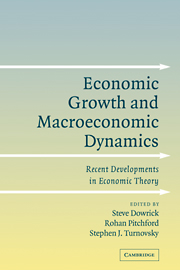4 - Delinearizing the Neoclassical Convergence Model
Published online by Cambridge University Press: 31 October 2009
Summary
DELINEARIZING THE NEOCLASSICAL CONVERGENCE MODEL
The empirical analysis of economic growth has become a major international research program, fueled in part by vigorous debate between proponents of models of endogenous growth, based on the accumulation of knowledge and ideas, and the defenders of the neoclassical growth model established by Trevor Swan and Robert Solow in their seminal papers, both published in 1956.
A central tenet of the neoclassical tradition is that the accumulation of factors for use in production, whether physical capital or intangible capital in the form of education and skills, is subject to a strict version of the “Law” of diminishing returns: namely, the Inada condition that the marginal product of capital tends toward zero as the stock of capital increases. This condition implies that capital accumulation cannot drive long-run growth in labor productivity or income per person, which must instead come from labor-augmenting technological progress. In the short run, however, the rate of capital accumulation influences the speed of transition from any historically determined starting point to the economy's steady state. As a general rule, the speed of transitional growth is decreasing in the ratio of current to steady-state capital intensity. Given common technology, differences in capital intensity translate into differences in labor productivity. It follows that, if we control for differences in the determinants of steady state, countries with low labor productivity will exhibit faster growth than countries with high labor productivity. This is the “conditional convergence” prediction of the neoclassical growth model.
- Type
- Chapter
- Information
- Economic Growth and Macroeconomic DynamicsRecent Developments in Economic Theory, pp. 83 - 94Publisher: Cambridge University PressPrint publication year: 2004



